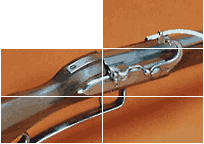
 |
|
|
Contributor Center: General Photo Guide
|
|
• Main
Information • Intro to Writing Guides • General Photo Tips New Articles • Guidelines • Submissions Discussion • Features Talk Support Us • Special Services • Our Bookstore • Make a Donation |
|
One that thing distinguishes myArmoury.com from many other sites that cater to a similar audience is the number and quality of our photographs. We work hard to bring you high-quality and consistent photos. We'd like our members to be able to share photographs of their own collections and so we'll try here to share some of the things we've learned through our own efforts.
Visitors come to this site and attempt to truly visualize the items you photograph in a three-dimensional space. The only tools they have available to them are stats, measurements, and your photos. The more images they have available to them, the better they can form a mental picture of the item. It often takes several photographs to adequately represent the true nature of an item. We suggest having at least two photos that are a standard, undistorted nature to provide the visitor with an "establishing shot". These photos will give a true indication of the item's proportions and measurements. Suggested Photographs Each item should have a FULL photograph shot top-down with no distortion:  Each sword or dagger should include at least one straight-on shot of the item with no distortion. If the weapon is asymmetrically complex, include a photo for the back, and possibly the side, too:    You may want to include several angles that demonstrate the item's shape. You may also want to include detail shots or photos that are angled to see specific areas of interest. This is your chance to have fun and really shoot the glamour shots of your item:   Ideally, your photographs should be presented on a common, visually simple background. Rolled vinyl, fabric, paper, wood, concrete, and the like are all suitable choices. We suggest avoiding photos with backgrounds that include cars, houses, lawn items, etc. Try to have your photo focus on the item, not the background. Visualize yourself shooting a catalog. Shooting a Sword  As an example, we'll outline a few things we consider when we shoot a sword for our hands-on reviews or collection galleries:
As an example, we'll outline a few things we consider when we shoot a sword for our hands-on reviews or collection galleries:The Top-Down Shot Your first image will be photographed in a straight-on, undistorted view. We've found that it's easiest to do this by placing the sword on the floor and getting directly above it. We generally stand about 5-7 feet over the sword and center the camera to the item. A better result is had if you center slightly more towards the hilt than the tip. This allows you to avoid looking like you're shooting from underneath the hilt. You must be careful to center the camera to the item or you'll end up getting a distorted photograph. If you are positioned too close to the tip of the sword, the blade will look very long. If you are positioned too close to the hilt, the hilt will look unusually large with a small and highly tapered blade. Don't forget to center on the other axis as well: directly above the blade.    The Straight-on Hilt Shots  Your next images will be that of the hilt. You'll want to shoot an undistorted view of the front of the hilt. If it's a complex hilt with asymmetry you'll include a back and side shot, too.
Your next images will be that of the hilt. You'll want to shoot an undistorted view of the front of the hilt. If it's a complex hilt with asymmetry you'll include a back and side shot, too.Place the sword on the floor and get 1-3 feet above it. Carefully center the sword hilt in the viewfinder, making certain you're directly in-line with it. You can look at the cross-guard and other items to ensure you're not looking "underneath" or "over" the hilt. Slightly off-centered positions may create drastically different photos and will make the sword look distorted.   Important Final Points There are many things to consider when doing any form of photography. Despite what the manufacturer claims, your camera does much more than simply "point and shoot". To get good results with product photography, you will need to spend a bit of time on setup, lighting, exposure, and focus. Please take a moment to read this list of basic suggestions:
|
|